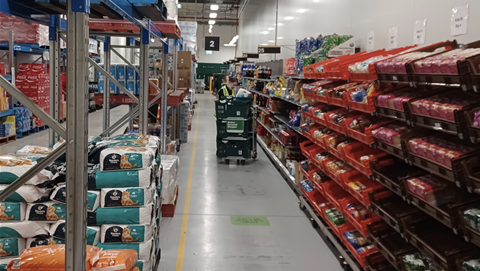NSW Health has drastically reduced the amount of time taken to return negative COVID-19 pathology results to patients using a SMS text bot engine that automates the contact process.
eHealth NSW chief information officer Zoran Bolevich told the AWS Summit in Sydney that the “really clever work” had “cut down the waiting time from days to hours” for patients.
It has also saved “thousands of hours of productive time” for NSW Health Pathology, which has performed the majority of Australia’s COVID-19 tests, and other healthcare workers.
The system, which was released just weeks into the height of the pandemic, was developed by AWS, Deloitte, Microsoft and Mulesoft to ease pressure on pathology and hospital staff.
Bolevich said it had enabled the state’s laboratory information system to “feed a negative result through an SMS text bot engine … and deliver those negative results to patients”.
“Once [patients] get swabbed in a clinic, they’re invited - should they wish to do so - to subscribe to an SMS text bot service,” he told a AWS media briefing on Wednesday.
“They go through a simple registration process, and once their result is available - if it is negative - they get an SMS text message, and that is all an entirely automated process.”
Before the system was introduced, patients were experiencing an anxious wait over several days to receive results, reducing the timeliness of information for public health officials.
“Naturally, [NSW Health Pathology’s] priority is to get those positive results into the hands of patients and public health officials quickly, so those patients can be isolated and take the right medical steps,” he said.
“What that means, however, then is that those patients with negative results - and that’s the vast majority thankfully - had to potentially wait for a number of days to receive that result, sometimes up to a week
“And that generates anxiety and makes patients stay at home in isolation, possibly longer than necessary.”
Bolevich said NSW Health Pathology had also “worked with AWS to spin up a call centre” to streamline their interactions with the public during COVID-19.
It is just one of a number of business units within NSW Health that have done so using Amazon Connect to ensure the “flow of reliable, timely information to [the] community”.
“We were able to quickly scale up our call centres using Amazon Connect,” he said.
“We’ve also created a number of new call centres in those areas of the business that found themselves under particular pressure and really high demand.”
The agency had previously moved its shared services contact centres to the cloud-based contact centre platform from an on-premises Avaya platform hosted in the GovDC.
The shift took place over an eight-week period last year as part of a broader digital transformation of the IT service desk.
Well prepared for COVID-19
Despite the need to build the SMS bot and scale up call centres, Bolevich said the state’s public health system had been well prepared for the coronavirus pandemic.
He put this down to significant IT investment in recent years. NSW Health expects to become a “fully digitally-enabled and integrated” healthcare system in around six years time.
“I’m pleased to say that, by and large, all the investments and hard work that we put into digitising NSW Health in the previous five to six years have really paid off,” he said.
“Our networks, data centres, back office systems, clinical systems like the electronic medical record and others performed exceptionally well, and enabled the health system to continue functioning.
“However, given that we did have that sharp increase in the use of digital tools, it was incredibly useful to be able to birth some of that increased traffic into the cloud.
“And this is where partnership with AWS has been critically important for us and enabled us to move the scale and ensure performance very quickly.”
Post pandemic
Like most corporates and government organisations, Bolevich is now contemplating what work looks like for Australia’s largest public health system following the coronavirus pandemic.
He said that NSW Health hoped that some of the flexibility afforded to its workforce during COVID-19 would be retained.
“I have 1400 staff in eHealth [NSW] and we switched to working from home overnight seamlessly and just continued operating and providing a great service,” he said.
“So as we move back to the previous way of operating, I hope it will not go all the way back.
“I hope that we can maintain and retain some of those good elements that we’ve learned from this experience.”
While Bolevich acknowledged that this would be harder for frontline staff, he said “virtual care and telehealth” was likely to play a greater role in the future.
“I think COVID, as disastrous as it has been, has been a really useful … trigger for health to seriously consider how we can embrace virtual care and telehealth and never go back again,” he said.
Bolevich said NSW Health’s state-wide video conferencing platform, which is use for everything from business meetings to patient video consultations from clinics, had witness an 18 fold increase on pre-COVID levels.
Virtual care
He also said there had been success stories around the remote monitoring of COVID-19 patients in Sydney Local Health District (LHD) using telehealth and virtual care solutions.
iTnews revealed NSW Health had bought thousands of Apple iPads for this very purpose last month, allowing the agency to observe patients from the comfort of their own home.
Bolevich said the LHD was “able to remotely monitor COVID-19 patients in their homes through means of video consultation and some pretty simply biometric devices that measure the oxygen levels in blood, which is an important parameter for this critical illness.”
“We think these types of applications, video consultations, remote monitoring and also clinical teams supporting one another … are the sorts of things that ... will be the last legacy of this otherwise pretty terrible situation,” he said.
“So we are actively developing plans and strategies to really embed and take to the next level virtual care and telehealth in NSW Health.”




.jpg&h=140&w=231&c=1&s=0)





















